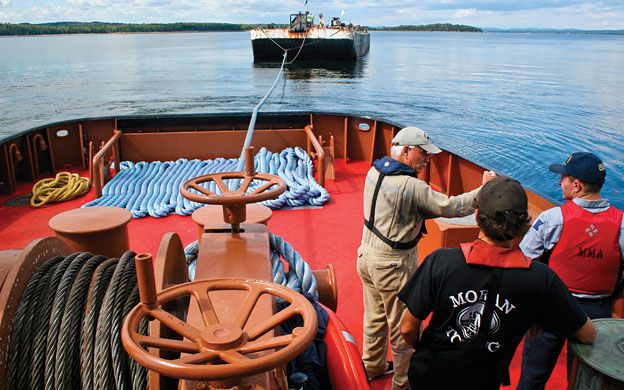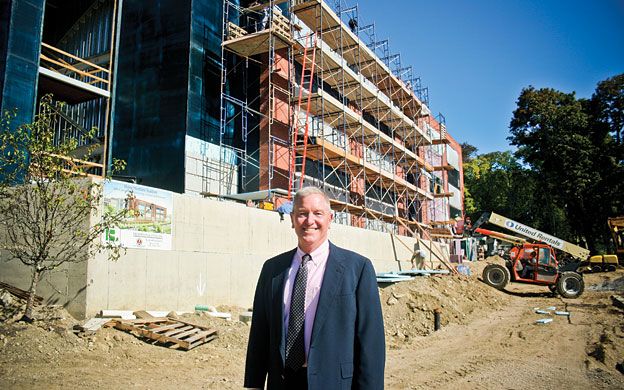Sea level to C-level: Maine Maritime Academy investing in tech
On a sunny September morning in Castine Harbor, the tug Pentagoet carefully maneuvers away from the 230-foot barge Oyster Bay.
Thick hawsers connecting the two vessels tauten as the Pentagoet gains distance, then tows the barge along a short loop.
The exercise is impressive, requiring expertise that balances nuanced ship handling with the sheer mass and gear of the ships themselves.
What's more impressive is that the vessels are standard classroom tools of an undergraduate education at Maine Maritime Academy. Preparing to haul lines at the moment are two seniors, Hollister Poole and Dennis La Komski. At age 21, Poole radiates confidence. No wonder. Already, she's gained plenty of real-world experience, having interned with a ship-assist company in Houston and an offshore tugboat moving oil rigs. After graduation, she says, she will go into ship assist or offshore supply in the Gulf of Mexico.
La Komski is 26. He first went to college for music, then got out on the water in a sailboat and never looked back. He just finished an internship with a Belgian company that delivers liquid natural gas globally.
“I got into this school for vessel operations and technology,” he says. “But I saw an LNG ship coming in the harbor one day and I thought, 'Oh, man, that is a cool-looking ship.'”
To keep pace with the demands of the maritime industry, MMA, which is one of the nation's six state-run maritime academies, in January will unveil its first new academic building in three decades, the $14 million, 30,000-square-foot ABS Center for Engineering, Science and Research, which is now under construction on the campus.
David Gardner, MMA's provost and vice president for academic affairs, says up to this point the faculty has done an excellent job of adapting outdated systems to current training needs. But modern shore-side training is essential to real-life application.
The new building will also be a hub for joint student/faculty research projects, including low-emissions biofuel development and testing, wind turbine design, tidal and wave hydrokinetic devices, ocean studies research, and other topics.
“This facility brings teaching into the 21st century,” Gardner says. “It gives us the cutting-edge technology we need to make sure our students are trained in the most current systems.”
A lifestyle with growing demands
Students like La Komski may be attracted by the lifestyle of working on a ship — what he calls a “lifestyle [and] the fact that you get a waterfront view from your office all the time.”
But, compared to their predecessors, students at the school will also receive a higher level of technical training and command higher salaries when they join the workforce.
Mark Ruge, an attorney for Washington, D.C.-based K&L Gates and counsel to the American Maritime Partnership, says the maritime academies provide an essential service by ensuring a steady flow of students trained to work at sea and in related shore-side professions such as shipbuilding and port operations. Most of the newly commissioned ship's officers are products of the maritime academies.
“The domestic American maritime industry is experiencing a renaissance,” says Ruge. “It's building vessels in numbers that haven't been seen in a generation.”
According to AMP, the U.S. commercial fleet comprises more than 40,000 vessels. The domestic maritime industry is responsible for almost 500,000 jobs, including 74,000 jobs on vessels and at shipyards; and annually moves 1 billion tons of cargo and transports more than 100 million passengers.
It used to be that many mariners moved up to become ship officers by what might be called an apprentice program, Ruge says. Today's sophisticated technological environment, and the complexity of rigorous national and international standards for new-officer training and certifications, have made the academies, all offering robust technical, science and engineering programs, more important than ever, he says.
“They're all producing people who help support the commercial maritime industry,” he says. “It's a rewarding career path because the commercial maritime industry provides both reliable employment to individuals and important economic, national and homeland security benefits to our country.”
Graduates can expect well-paying jobs, says Ruge.
“The six academies have almost a 100% placement rate for their licensed students,” he says. “The industry is in need of people. Consistently, the academies are ranked on national lists as the best return on tuition dollars.”
But Ruge echoes La Komski's sentiment: It's not all about money: “Oftentimes, people just like to be out on the water. It has a certain allure.”
MMA, on the Blue Hill peninsula in Castine, was founded in 1941. It occupies 35 acres on a steep hillside formerly the site of a teacher-training college. Today MMA is Hancock County's third-largest employer, and enjoys a symbiotic relationship with the town.
With an undergraduate student body of 994, 70% from Maine, MMA offers 18 degree programs in engineering, management, science and transportation, with the option of studying while part of a military training program.
Tuition for the four years is $105,000, with average student debt at $32,800. Its job placement rate is more than 90% within 90 days of graduation, and early career earnings can be between $60,000 and $100,000 for many maritime and land-based occupations. These are figures that put retention and graduation rates well above national averages, and landed MMA this year as No. 12 on Money magazine's list of “best colleges for your money,” and No. 1 on its “best public colleges and universities” list, in a review of 665 institutions.
Like other maritime academies, MMA is known for hands-on education using training tools, research opportunities and internships modeled on and partnering with real-world occupations. On this September day, early in a new semester, some students conduct fire drills aboard MMA's 500-foot training ship, the State of Maine, while others board the research vessel Friendship and head out to conduct marine studies. In a cavernous machine shop, students make ship parts on industrial-grade machinery. In the power lab, they break down and piece back together enormous ship engines.
At four bridge simulators, sophomores use complicated electronics and terrestrial navigation points to confirm calculations they've made on paper charts. Later, they'll learn celestial navigation using sextants, compasses and the stars. On a “green” workboat, students experiment with low-emissions biofuels as part of a U.S. Department of Transportation grant.
In the geology lab, Alison Mitchell, a double major senior in marine biology and small-vessel operations, uses a 3D printer to create artificial hermit crab shells as part of a shell-selection experiment. In a class devoted to refrigeration and air-conditioner mechanics, students, some in grease-covered clothes from the day's previous real-life lessons, draw schematics. They will soon take licensing exams for certification as engineering officers in the U.S. Merchant Marine. Their instructor is retired Navy Cmdr. Hank Stewart, an MMA graduate who returned to teach.
“A lot of us have spent years on ships and have returned to MMA to pass our experience on to the next generation of mariners,” says Stewart.
The world and MMA have a comfortable relationship, whether it's attracting international students such as Ashwini Krishnan, from India, or sending students out to put their training to use. Krisy Kelley, a Maine native and marine biology major, recently returned from Alaska, where she spent three months as a quality assurance technician with Trident Seafood. A junior in the international business and logistics program, Zachary Radcliffe spent the summer helping Bath Iron Works transition to a just-in-time paint delivery system. Jason Magee, a 22-year-old New Jersey native, has traveled globally through his studies. A junior in the marine systems engineering program and a Coast Guard trainee, he took part in the State of Maine's training cruise to the Caribbean, then participated in military sealift operations as part of RIMPAC 2014, the world's largest international maritime exercise.
This is just a taste of student activity on a given day. That activity is seeing significant enhancement with construction of the new ABS Center for Engineering, Science and Research, financed by $4.5 million in state funding and about $10 million in gifts and grants, with additional U.S. Department of Transportation funds to develop a Marine Engine Testing and Emissions Laboratory. The first new classroom construction here in three decades, the three-story building will provide state-of-the-art laboratories, classrooms, student study spaces, faculty offices and workrooms.
Dump trucks back and fill while workers on scaffolds tend to masonry, aiming for completion in January 2015. The new building represents an expansion of MMA's teaching and research capabilities.
“We've got an increasing emphasis here on research, both for faculty and students,” says the MMA's Gardner. “A number of faculty members are working under recently acquired research grants, particularly in engineering. We also just won an Arctic ice navigation training grant from the U.S. Department of Homeland Security Science and Technology Directorate. So across campus, we have external grant agencies recognizing the expertise represented here on the faculty, and we involve students in that research because those skills are important for entering the job market and for going on to graduate school.”
By all accounts, the career-oriented approach that informs MMA's mission is precisely what draws students. Young adults who persist here have a pretty good idea of what they want to do in life. And MMA is there to help.
“It's been great,” says Magee, the engineering student. “There's no stopping you here.”
Read more
PenBay Solutions develops a GIS tool for mapping what's inside buildings












Comments